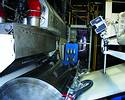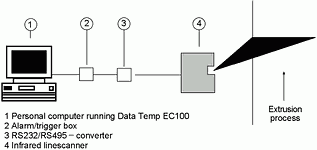

Consistent product temperature profiles are critical in continuous web applications such as plastic extrusions or extrusion coating.
Typically, process temperatures are adjusted in open-loop fashion without realtime product temperature feedback. But, non-contact infrared linescanners can provide edge-to-edge temperature measurement feedback on extrusion processes.
The Thermalert EC100 system from Raytek is an automated surface inspection system for detecting, measuring and classifying defects on products made in extrusion processes. With the continuous production control and the early detection of extrusion defects (waving or running edges, gaps) the customer can improve the manufacturing process and avoid scrap to achieve a zero defect standard of quality.
To monitor the plastic-coated product's temperature and ensure precise temperature control, an infrared linescanner is positioned immediately after the extruder, prior to the chill rolls. Proper web temperature at this location is critical for strong plastics-to-paper-substrate adhesion. Cross-web temperature variation, a key determinant of coating thickness uniformity, also is controlled by the linescanner at the extruder's die zone heaters. Maintaining a consistent temperature profile improves the product's finished appearance, dimensional stability and folding endurance. Graphical software generates realtime process images for enhanced monitoring and control during start up and operation, allowing processors to increase productivity and improve product quality.
The demand for vendors to follow ISO 9000 certification procedures is increasingly important also in the plastics and packaging industries. ISO 9000 requires an organisation to establish, document, and maintain a quality system to ensure that its product conforms to specified requirements. This quality system is intended to complement the technical requirements of the product. Many companies are writing standards for documenting and monitoring temperature for inclusion in their ISO 9000 process control issues and these include procedures accepting materials into a process, statistical process control, and proper maintenance of process equipment. Temperature measurement and documentation is frequently critical to these issues.
The Thermalert EC100 system includes the Raytek Thermalert MP40 infrared linescanner with laser sighting and mounting accessories, the Windows NT software program DataTemp EC100, an interface converter and an alarm/trigger box, see Figure 1.

Principle of operation
Energy is emitted by all objects with a temperature greater than absolute zero. Infrared thermometers measure this surface radiation and determine temperature. Basically, as the amount of emitted radiation increases, temperature increases. Using that principle the infrared linescanner measures multiple temperature points across the surface of the extruded material. In the linescanner a motorised mirror scans the web at a speed of up to 20 lines per second (20 Hz). A lens/filter assembly collects infrared radiation at 256 points within a 90° field-of-view, and the energy is reflected onto a photo-detector. The amplified signal is digitised and processed by a high-speed microprocessor that calculates the temperature of the individual measurement points in realtime.
An internal blackbody system standardises the sensor on every scan, providing continuous self-calibration for accurate, repeatable measurement over time. The scanning system uses the optimal wavelength of 3,43 µm for thin film plastics (7,9 µm is an option for certain polymer types). The linescanner is connected to a standard personal computer with a common serial interface RS232. High scan and data transmission speeds up to 57,6 baud enable rapid online thermal imaging of fast moving extrusion processes. The two-way RS485 communication between the scanner and the host PC in the control room support remote configuration of the linescanner.
The Thermalert EC100 software runs on a standard personal computer, is easy to use and requires little operator training. By monitoring the extrusion coating process, the software allows the temperature data to be visualised as a line graph (profile) and a multicolour thermal image simultaneously. Temperature profiles and images can be achieved for future analysis or printed out for customer documentation or quality certification programs such as ISO 9000.
The DataTemp EC100 graphical software can display realtime profiles and thermal images of edge-to-edge product temperature. Machine operators can zoom into the temperature profile to get a closer look for instant on-screen analysis. Using these graphical displays, the operator can detect process temperature non-uniformities and make immediate adjustments. Separate windows can be sized and displayed simultaneously, allowing operators to monitor, record or play back temperature data for side-by-side comparison. The system allows the automatic detection of edge problems and temperature gaps during the extrusion process independent of product size changes.
The Thermalert EC100 is designed for use in plastic industries where monitoring and controlling of extrusion processes is critical to productivity and product quality.
Handheld unit
As well as the in line scanner, Raytek produce a handheld non-contact temperature indicator, designed specifically for the monitoring of temperature on thin film plastic sheets. This unit, the Raytek MX2P3 is a simple point and shoot device that reads the thin film temperature on a LCD Display. The unit is set for a temperature range of 100 to 350°C with a response wavelength of 3,43 µm, which is that of the infrared emitted by the thin film plastic. Accuracy is within 1°C and the unit is fitted with a 'True Spot', 3-dot laser sighting device so the user knows where the temperature spot reading is positioned. Maximum and minimum temperatures are also displayed on the backlit LCD display. The Raytek MX2P3 is at present in use all over the world and is a valuable tool when commissioning the machine or setting up after outages.
| Tel: | +27 11 608 1551 |
| Email: | [email protected] |
| www: | www.randci.co.za |
| Articles: | More information and articles about R&C Instrumentation |

© Technews Publishing (Pty) Ltd | All Rights Reserved